Have you ever wondered about the diverse geography and stunning landscapes of the Philippines? What if I told you there’s a detailed map picture that can take you on a visual journey through the country’s enchanting regions and attractions? Prepare to be amazed as we uncover the hidden gems and natural wonders of the Philippines, all through the lens of a captivating map.
Key Takeaways:
- Explore the Philippines’ archipelago comprised of over 7,000 islands and islets
- Discover the stunning beaches, mountain ranges, and natural wonders that make up the country’s diverse geography
- Learn about the rich cultural heritage influenced by various colonizers throughout history
- Uncover the top tourist attractions and famous landmarks in the Philippines
- Understand the economic overview and significance of natural resources in the country
Geographic Location of the Philippines
The Philippines is a stunning archipelago situated in Southeast Asia, nestled in the western Pacific Ocean. It enjoys a strategic location, with Taiwan to the north, Vietnam and Malaysia to the west, and Indonesia to the south. The country is divided into three main island groups: Luzon, Visayas, and Mindanao, each offering its own unique charm and attractions.
The Philippines’ geographic location makes it a prime destination for travelers seeking a tropical paradise. Its proximity to other Southeast Asian countries makes it easily accessible for international visitors.
“The Philippines is an island paradise located in the heart of Southeast Asia, surrounded by crystal-clear waters and breathtaking natural landscapes. Its strategic location allows visitors to explore neighboring countries and experience the rich cultural diversity of the region.”
The Three Main Island Groups:
- Luzon: The largest island group, known for its bustling capital city of Manila, stunning mountain ranges, and picturesque rice terraces.
- Visayas: A group of islands famous for its white sand beaches, turquoise waters, and vibrant marine biodiversity.
- Mindanao: The southernmost island group, home to lush rainforests, majestic waterfalls, and diverse indigenous cultures.
Whether you’re looking to relax on pristine beaches, delve into vibrant city life, or embark on thrilling outdoor adventures, the Philippines’ geographic location offers a plethora of opportunities to satisfy every traveler’s wanderlust.
| Location | Bordering Countries/Seas |
|---|---|
| Taiwan | Northern Border |
| Vietnam, Malaysia | Western Border |
| Indonesia | Southern Border |
Philippines Map and Divisions
The Philippines is a country with diverse geographical regions. It can be divided into 18 distinct regions, each offering unique features and attractions. These regions are primarily categorized into three main island groups: Luzon, Visayas, and Mindanao. Let’s explore each of these divisions and discover what makes them special.
Luzon
Luzon is the largest and most populous island group in the Philippines. It is home to the country’s capital, Manila, and serves as the political and economic center. Luzon is characterized by its bustling cities, stunning landscapes, and historical sites such as the UNESCO World Heritage-listed town of Vigan. The region also boasts the famous Banaue Rice Terraces, known as the “Eighth Wonder of the World,” and the majestic Mount Mayon, an active volcano renowned for its perfect cone shape.
Visayas
The Visayas region is located in the central part of the Philippines and consists of several islands, including Cebu, Bohol, and Negros. This group of islands is known for its beautiful beaches, crystal-clear waters, and vibrant marine life. Dive enthusiasts flock to destinations like Moalboal, Malapascua, and Apo Island to explore the rich underwater ecosystems. The Visayas region is also home to cultural gems like the Chocolate Hills in Bohol and the historical sites of Iloilo.
Mindanao
Mindanao is the southernmost and second-largest island group in the Philippines. It is known for its natural wonders and cultural diversity. Mindanao is a destination for outdoor enthusiasts, offering opportunities for trekking, exploring caves, and river cruising in places like the Enchanted River and Tinuy-an Falls. The region is also rich in cultural heritage, with indigenous tribes preserving their unique traditions and crafts.
The map of the Philippines clearly delineates these divisions, providing a visual representation of the country’s regions. It helps visitors and enthusiasts navigate through the diverse landscapes and plan their exploration accordingly.
| Island Group | Highlighted Regions |
|---|---|
| Luzon | Ilocos Region, Cagayan Valley, Central Luzon, Calabarzon, Mimaropa, Bicol Region, Cordillera Administrative Region, National Capital Region |
| Visayas | Western Visayas, Central Visayas, Eastern Visayas |
| Mindanao | Zamboanga Peninsula, Northern Mindanao, Davao Region, Soccsksargen, Caraga, Bangsamoro Autonomous Region in Muslim Mindanao |
Exploring the different divisions of the Philippines allows travelers to immerse themselves in the diverse cultures, landscapes, and experiences that each region offers. Whether it’s the vibrant megacities of Luzon, the pristine beaches of Visayas, or the natural wonders of Mindanao, there is something for everyone in this beautiful archipelago.
Geographic Features of the Philippines
The Philippines is a country that boasts a diverse range of geographic features, making it a paradise for nature lovers and adventure seekers. From stunning beaches to majestic mountains, the Philippines offers a plethora of natural wonders to explore.
Beautiful Beaches
One of the Philippines’ greatest attractions is its pristine beaches. With over 7,000 islands, the country is blessed with countless stretches of powdery white sand, crystal-clear waters, and vibrant marine life. Popular beach destinations include Boracay, Palawan, and Siargao, where visitors can indulge in activities such as swimming, snorkeling, and island hopping.
Majestic Mountains
The Philippines is home to breathtaking mountain ranges that attract hikers and mountaineers from around the world. Among these peaks is Mount Apo, located in Mindanao, which stands at an impressive height of 9,692 feet and is considered the highest mountain in the country. Other notable mountains include Mount Pulag in Luzon and Mount Kitanglad in Visayas. These mountains offer stunning panoramic views and provide opportunities for thrilling outdoor adventures.
Natural Wonders
Aside from its beaches and mountains, the Philippines is also known for its remarkable natural wonders. From the surreal beauty of the Chocolate Hills in Bohol to the fascinating underground river of Puerto Princesa in Palawan, these natural attractions never fail to awe visitors with their unique landscapes. Be it exploring the enchanting Hinatuan Enchanted River or witnessing the majestic Tubbataha Reefs Natural Park, the Philippines is a treasure trove of natural marvels.
“The Philippines is a land of natural wonders, where stunning beaches, majestic mountains, and surreal landscapes coexist harmoniously.”
With its diverse geography encompassing captivating beaches, towering mountains, and awe-inspiring natural wonders, the Philippines truly showcases Mother Nature’s mastery. Whether you seek an idyllic beach getaway or an adrenaline-pumping mountain adventure, this country has it all.
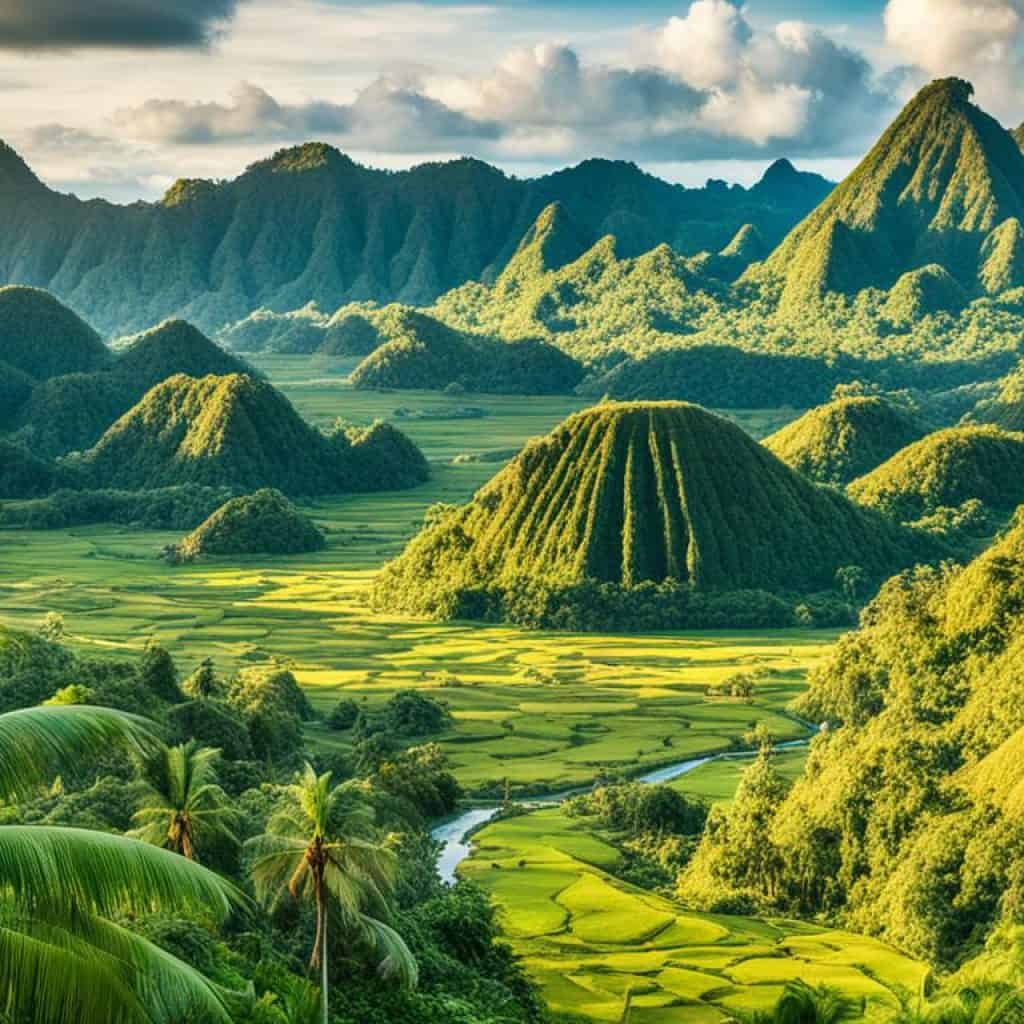
Climate and Weather in the Philippines
The Philippines experiences a tropical climate characterized by high temperatures, high humidity, and distinct wet and dry seasons. The country’s geographic location near the equator contributes to its warm weather throughout the year, providing a favorable environment for abundant flora and fauna.
The tropical climate in the Philippines makes it an ideal destination for those seeking warm and sunny weather. Whether you’re looking to relax on the beautiful beaches or explore the diverse natural landscapes, the Philippines offers an alluring climate for outdoor activities.
The country has two distinct seasons – the wet season and the dry season – each offering unique experiences.
Wet Season in the Philippines
The wet season in the Philippines typically begins in June and lasts until November, coinciding with the typhoon season. During this time, the country experiences heavy rainfall and occasional tropical storms or typhoons, which are common in the region. These weather events bring both challenges and benefits to the Philippines.
“The Philippines is prone to typhoons due to its location in the western Pacific Ocean. These powerful weather disturbances can cause heavy rain, strong winds, and flooding in affected areas.”
The wet season provides a lush and vibrant environment, with the country’s flora thriving in the abundant rainfall. It also offers a unique opportunity to witness the beauty of waterfalls, as the cascades flow with greater intensity during this time.
Dry Season in the Philippines
The dry season in the Philippines begins in December and extends until May. It is characterized by lesser rainfall, lower humidity, and generally higher temperatures. The dry season is a popular time for tourists as it offers sunny and clear skies, making it perfect for outdoor activities and beach visits.
The diverse climate patterns in the Philippines provide travelers with the option to choose the best time to visit based on their preferences and desired activities.
Typhoons and Safety Precautions
The Philippines is prone to typhoons due to its geographical location and proximity to warm ocean waters. These powerful tropical cyclones can bring strong winds, heavy rains, and storm surges, causing potential damage and disruptions. It is important to stay informed about weather updates and follow safety precautions during typhoon season.
“During the typhoon season, it is advised to stay updated with local and national weather reports, heed evacuation warnings, and have emergency supplies readily available.”
By being prepared and vigilant, both locals and tourists can ensure their safety during typhoon events and have a better understanding of the country’s climate and weather patterns.
Cultural and Historical Significance of the Philippines
The Philippines showcases a fascinating fusion of cultures and a rich historical background, making it a unique and culturally diverse country. Influenced by various colonizers, including Spain, Japan, and the United States, the Philippines has developed a vibrant cultural heritage that reflects its complex history.
With roots in Malay, Spanish, Chinese, and American cultures, the Philippines has a diverse range of traditions, languages, and customs. These cultural influences are evident in the country’s architecture, cuisine, music, and festivals.
Traditional festivals hold a special place in Philippine culture, with each region showcasing its own unique celebrations. The Sinulog Festival in Cebu, the Panagbenga Festival in Baguio, and the Ati-Atihan Festival in Kalibo are just a few examples of the colorful and lively events that take place throughout the year.
Furthermore, the Philippines has a deep connection to its historical landmarks and sites. Intramuros in Manila, the fortified city built during the Spanish colonial period, stands as a testament to the country’s colonial past. The Banaue Rice Terraces, recognized as a UNESCO World Heritage Site, represent the ancient agricultural practices of the indigenous people of the Cordillera region.
Overall, the cultural and historical significance of the Philippines is an integral part of its identity, shaping its traditions, values, and sense of unity. Exploring the country’s rich cultural heritage and historical sites offers a deeper understanding of its unique and diverse tapestry.
Philippines Tourism and Attractions
The Philippines is a treasure trove of breathtaking tourist attractions that will leave visitors in awe. From its stunning natural wonders to its picturesque beaches, the country offers a myriad of experiences for travelers. Whether you’re a nature enthusiast, a beach lover, or a culture seeker, the Philippines has something for everyone.
One of the top tourist attractions in the Philippines is Palawan. This idyllic island province is home to the world-renowned Puerto Princesa Underground River, a UNESCO World Heritage Site. Explore the fascinating cave system adorned with impressive rock formations and an underground river that flows directly into the sea. It’s a unique adventure that will take your breath away.
Another must-visit destination in the Philippines is Bohol, known for its iconic Chocolate Hills. These perfectly cone-shaped hills covered in lush greenery turn brown during the dry season, resembling chocolate kisses scattered across the landscape. The Chocolate Hills are a true marvel of nature and a sight to behold.
- Palawan: Puerto Princesa Underground River
- Bohol: Chocolate Hills
No trip to the Philippines is complete without exploring its stunning beaches. Cebu, a vibrant and bustling province, boasts some of the most beautiful beaches in the country. Dive into crystal-clear waters, snorkel among vibrant coral reefs, and relax on powdery white sand beaches. Cebu’s beaches are the epitome of tropical paradise.
To showcase the natural beauty of the Philippines, here is an image of the stunning beaches in Cebu:
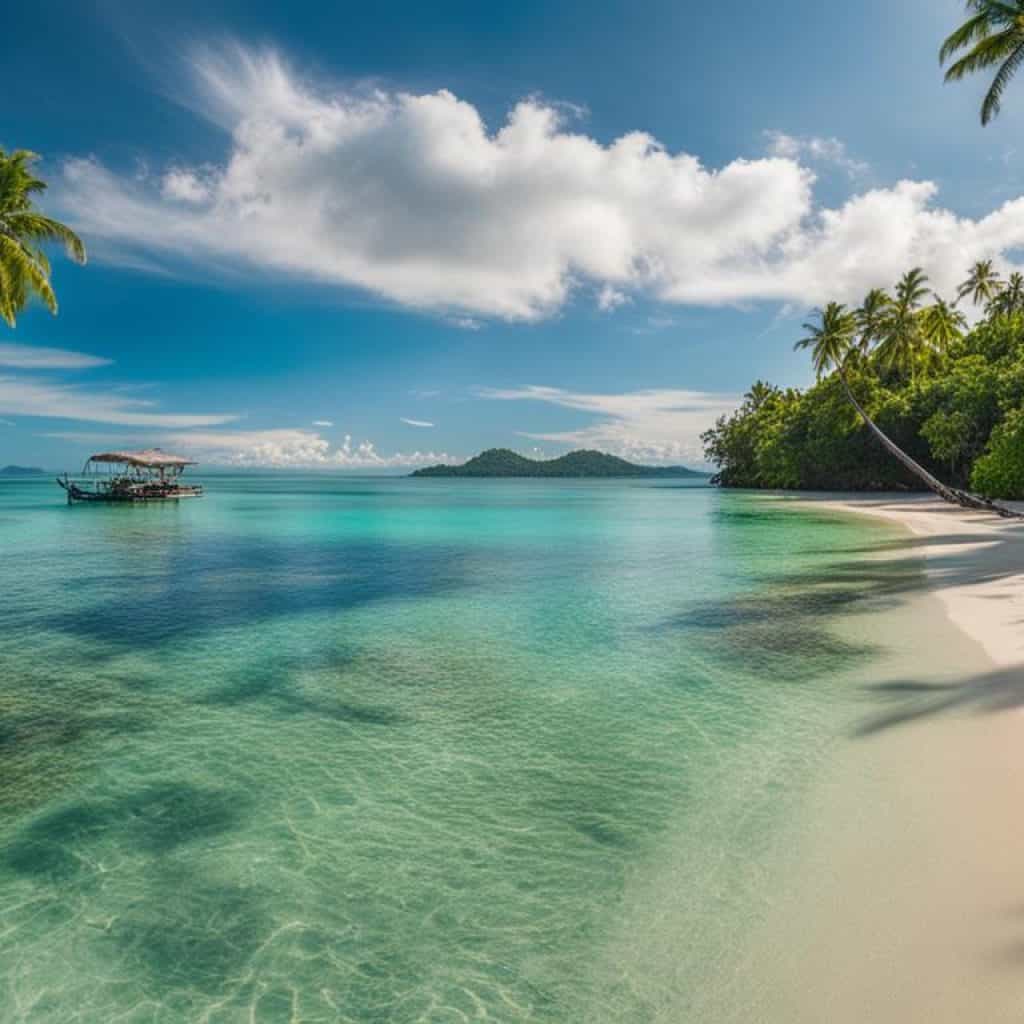
When it comes to tourist spots in the Philippines, the options are endless. Explore the pristine islands of El Nido, experience the vibrant nightlife in Manila, or immerse yourself in the rich cultural heritage of the Ifugao people by visiting the Banaue Rice Terraces. The Philippines offers a diverse range of attractions that cater to every traveler’s interests.
Embark on an unforgettable journey to the Philippines and discover why it is hailed as one of the best destinations in the world.
Philippines Natural Resources
The Philippines is blessed with abundant natural resources that contribute significantly to its economy. These resources include:
- Cobalt
- Silver
- Gold
- Nickel
- Copper
- Salt
- Timber
- Petroleum
These natural resources are vital for various industries in the Philippines, such as mining, manufacturing, and energy production. The mining sector, in particular, benefits from the country’s abundance of minerals, including nickel, copper, and gold.
“The natural resources of the Philippines play a crucial role in driving economic growth and development in the country. They provide valuable raw materials for industries and contribute to job creation and revenue generation.” – Department of Environment and Natural Resources
The petroleum industry in the Philippines is also significant, as the country has potential oil and gas reserves that can fuel its energy needs. Exploring and harnessing these resources can reduce dependency on imported fuel and promote energy security.
It is essential for the Philippines to responsibly manage and sustainably utilize its natural resources to ensure their long-term availability. Proper environmental protection measures and regulations should be in place to prevent exploitation and promote sustainable practices.
Comparison of Selected Natural Resources in the Philippines
| Resource | Production | Uses |
|---|---|---|
| Cobalt | 5,000 metric tons (estimated) | Battery production, alloy manufacturing |
| Silver | 34,000 kilograms (2019) | Jewelry, electronics, photography |
| Gold | 40,000 kilograms (2019) | Jewelry, investment, industrial |
| Nickel | 340,000 metric tons (2019) | Stainless steel production, batteries |
| Copper | 660,000 metric tons (2019) | Electronics, construction, plumbing |
| Salt | 1.1 million metric tons (estimated) | Food processing, chemical industry |
| Timber | 1.7 million cubic meters (estimated) | Construction, furniture, paper |
| Petroleum | 5,000 barrels per day (estimated) | Energy production, transportation |
These figures are approximate and subject to change based on ongoing exploration and production activities.
Environmental Issues in the Philippines
The Philippines is facing several environmental issues that pose significant challenges to its ecosystems and natural resources. These issues include deforestation, soil erosion, air and water pollution, as well as the degradation of coastal mangrove swamps and coral reefs. It is vital to address these problems and take proactive measures towards sustainable practices to protect and preserve the country’s unique environment.
Deforestation in the Philippines
Deforestation is a major environmental concern in the Philippines, with vast areas of forest being cleared for agriculture, logging, and urban development. This widespread deforestation has detrimental effects on biodiversity, disrupts ecosystems, and contributes to climate change.
Pollution in the Philippines
Pollution, both air and water, is a pressing environmental issue in the Philippines. Industrial activities, inadequate waste management systems, and the use of fossil fuels contribute to air pollution, leading to respiratory problems and other health issues. Water pollution, caused by improper waste disposal and untreated industrial and domestic wastewater, poses risks to aquatic life and human health.
Coastal Degradation in the Philippines
The degradation of coastal mangrove swamps and coral reefs is another significant environmental concern. Mangroves serve as vital habitats for various species, provide protection against storms, and help maintain the balance of marine ecosystems. Similarly, coral reefs support a vast array of marine life and contribute to coastal protection. Destructive fishing practices, pollution, and climate change impact these delicate ecosystems, jeopardizing their ecological stability.
Efforts are being made by the government, non-governmental organizations, and local communities to address these environmental issues and promote sustainable practices. Reforestation programs, stricter regulations on waste management, and the establishment of marine protected areas are some of the initiatives aimed at conserving the Philippines’ natural resources and protecting its unique biodiversity.
Political Divisions of the Philippines
The political divisions of the Philippines consist of provinces and cities, each with its own local government. These divisions play a crucial role in the governance and administration of the country.
Provinces in the Philippines
The Philippines is divided into 81 provinces, with each province having its own unique characteristics and resources. Provinces are further divided into municipalities and cities. Some of the provinces in the Philippines include:
- Manila
- Cebu
- Davao
- Quezon
Each province has its own local government, responsible for the delivery of public services and the implementation of policies that cater to the needs of its constituents.
Cities in the Philippines
In addition to provinces, the Philippines also has numerous cities that are separate political entities. These cities are centers of commerce, culture, and urban development. Some of the major cities in the country include:
- Manila
- Cebu
- Davao
- Quezon City
These cities have their own local city governments, which oversee various urban services and initiatives to ensure the welfare and progress of their residents.
Having a well-structured political division allows for effective governance and the efficient delivery of public services to the people of the Philippines.
| Province | Capital |
|---|---|
| Manila | Manila City |
| Cebu | Cebu City |
| Davao | Davao City |
| Quezon | LucenaCity |
Philippines Historical Background
The history of the Philippines is a complex tapestry woven with periods of colonization, struggle for independence, and cultural assimilation. The country’s historical background is marked by the influence of various foreign powers, including Spain, Japan, and the United States. Each wave of colonization has shaped the nation’s identity and created a unique blend of cultures and traditions.
Spanish rule in the Philippines began in the 16th century when Ferdinand Magellan arrived in the archipelago in 1521. The Spanish colonizers established a colonial government and imposed their language, religion, and culture on the indigenous population. Over the next three centuries, the Philippines became a hub of Spanish influence in Asia, with Manila serving as the center of trade and Christianity in the region.
“The Philippines was a Spanish colony for more than three centuries, leaving an indelible mark on the country’s culture, religion, and language.”
The Philippine colonization by Spain had enduring impacts on the country’s cultural and social fabric. Catholicism, introduced by the Spanish missionaries, became the dominant religion, and Spanish became the official language. The Spanish rule also led to the emergence of a distinct Filipino identity shaped by a fusion of indigenous, Spanish, and Asian influences.
The Philippines’ fight for independence began in the late 19th century with the rise of nationalistic movements. Inspired by the ideals of liberty and independence, Filipino revolutionaries like Jose Rizal and Andres Bonifacio led the charge against Spanish colonization. The Philippine Revolution, which erupted in 1896, sought to free the country from Spanish rule and establish an independent nation.
After a tumultuous struggle, the Philippines finally gained independence from Spain on June 12, 1898. However, shortly after, the country fell under American control as a result of the Spanish-American War. The United States ruled the Philippines until 1946, when the country achieved full independence. This period of American influence left an imprint on the Philippines’ political system, educational institutions, and culture.
The quest for independence has played a significant role in shaping the Philippines into the resilient and diverse nation it is today. The struggles and sacrifices of the Filipino people during the colonial era laid the foundation for a strong sense of national identity and the preservation of traditional customs and values.
Throughout its history, the Philippines has overcome numerous challenges and faced periods of conflict, but it remains a country proud of its heritage and cultural roots. The Philippines’ historical background serves as a reminder of the resilience and determination of its people, as well as a testament to the power of unity in the face of adversity.
Famous Landmarks in the Philippines
The Philippines is renowned for its plethora of famous landmarks, showcasing both historical sites and cultural landmarks. These iconic destinations offer visitors a glimpse into the rich heritage and diverse culture of the country.
Intramuros, Manila
One of the most significant historical sites in the Philippines is Intramuros, located in the heart of Manila. This walled city is a testament to the Spanish colonial era and is home to well-preserved structures and landmarks such as Fort Santiago, San Agustin Church, and Casa Manila. Exploring Intramuros allows visitors to step back in time and immerse themselves in the country’s colonial past.
Banaue Rice Terraces
The Banaue Rice Terraces, often referred to as the “Eighth Wonder of the World,” are an awe-inspiring example of centuries-old agricultural ingenuity. Carved into the mountains of Ifugao, these terraces were built by the indigenous people using traditional methods. The intricate irrigation system sustains the terraces and adds to their breathtaking beauty. Visitors can witness the lush green fields, cascading down the mountainside, creating a mesmerizing natural landscape.
San Agustin Church, Iloilo
San Agustin Church, located in Iloilo City, is one of the oldest churches in the Philippines. Recognized as a UNESCO World Heritage Site, this architectural gem exemplifies the Baroque style and boasts stunning interior and exterior designs. The church is adorned with intricate carvings, detailed murals, and a grand altar, making it a must-visit destination for both history and art enthusiasts.
These are just a few examples of the famous landmarks that await visitors to the Philippines. Whether you are exploring the historical sites of Intramuros, marvelling at the terraced landscapes of Banaue, or admiring the grandeur of San Agustin Church, each landmark offers a unique experience and a deeper understanding of the country’s history and culture.
Languages and Ethnic Diversity in the Philippines
The Philippines is renowned for its vibrant linguistic and ethnic diversity, making it a culturally fascinating nation. With over 100 languages spoken throughout its islands, the country embraces a rich tapestry of linguistic heritage. Notably, Filipino and English are the official languages of the Philippines.
The ethnic makeup of the Philippines consists of various indigenous groups and influences from neighboring countries. The indigenous peoples, such as the Tagalog, Cebuano, and Ilocano, contribute significantly to the diverse cultural fabric of the nation. Additionally, the Philippines has been influenced by other cultures throughout its history, including Chinese, Malay, Spanish, and American cultures.
“The Philippines is a melting pot of cultures and languages, which is reflected in its vibrant traditions, cuisine, and customs.” – Dr. Maria Santos, Cultural Anthropologist
This cultural fusion creates a captivating blend of traditions, arts, and beliefs that illustrate the unique identity of the Filipino people. Cultural practices, festivals, and art forms, such as traditional dances like the tinikling, singkil, and pandanggo sa ilaw, showcase the rich heritage passed down through generations.
Significance of Language in Filipino Culture
Language holds immense importance in Filipino culture as it serves as a bridge that connects different communities and preserves the shared history of the Filipino people. It plays a vital role in the transmission of cultural values, beliefs, and identity.
Moreover, the use of Filipino and English as official languages promotes unity and communication across different regions of the Philippines. It allows Filipinos from various linguistic backgrounds to communicate effectively and fosters a sense of national identity.
The linguistic and ethnic diversity of the Philippines is a testament to the rich tapestry of cultural traditions that contribute to the country’s unique identity.
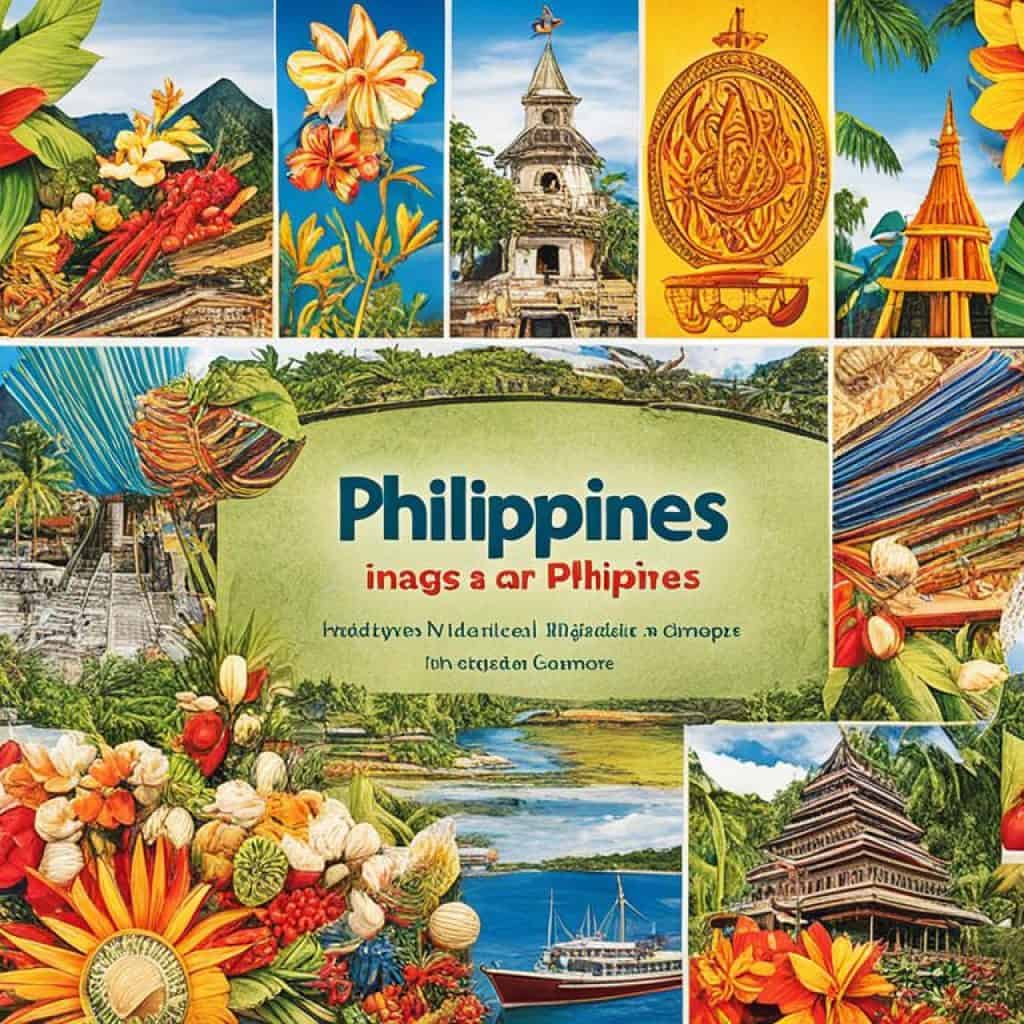
Economic Overview of the Philippines
The Philippines is experiencing a robust and growing economy, with various industries contributing to its success. Three key sectors that play a significant role in the country’s economic development are manufacturing, services, and tourism.
Manufacturing
The manufacturing industry in the Philippines is thriving and has become a major driver of economic growth. The country is known for its production and export of electronics, garments, and automotive parts.
Services
The services sector also plays a crucial role in the Philippine economy. It encompasses a wide range of industries, including business process outsourcing (BPO), information technology, finance, and real estate. The BPO industry, in particular, has experienced substantial growth, attracting multinational companies to set up operations in the country.
Tourism
Tourism is another vital contributor to the Philippine economy. The country’s natural beauty, stunning beaches, and rich cultural heritage attract millions of tourists from around the world. Popular tourist destinations include Palawan with its Puerto Princesa Underground River, the Chocolate Hills in Bohol, and the breathtaking beaches of Cebu.
“The Philippines offers a diverse and beautiful landscape, rich in natural resources and cultural heritage. With its unique geography and vibrant culture, it is a fascinating country to explore.”
The export sector also contributes significantly to the economy. The Philippines exports various products, including electronics, garments, agricultural products, and commodities such as coconut oil and petroleum. These exports help boost the country’s trade and further stimulate economic growth.
Overall, the Philippines’ growing economy, supported by industries like manufacturing and services, coupled with its thriving tourism sector and export activities, positions the country for continued economic success.
Conclusion
The Philippines is a country of breathtaking beauty and cultural richness. With its diverse landscape, from stunning beaches to towering mountains, the Philippines offers a myriad of natural wonders for visitors to explore. The vibrant culture, shaped by a complex history and diverse ethnic groups, adds depth and authenticity to the Philippine experience.
A picture of the map of the Philippines serves as a visual guide to navigate through the different regions and attractions of the country. It provides a glimpse of the remarkable diversity and scenic beauty that awaits travelers, from the bustling cityscape of Manila to the pristine beaches of Palawan and the iconic Chocolate Hills of Bohol.
Whether you are an adventure seeker looking to climb Mount Apo or a history enthusiast eager to explore the centuries-old Spanish colonial architecture in Intramuros, the Philippines offers something for everyone. Immerse yourself in the warm hospitality and vibrant traditions of the Filipino people as you embark on a journey of discovery and adventure in this tropical paradise.
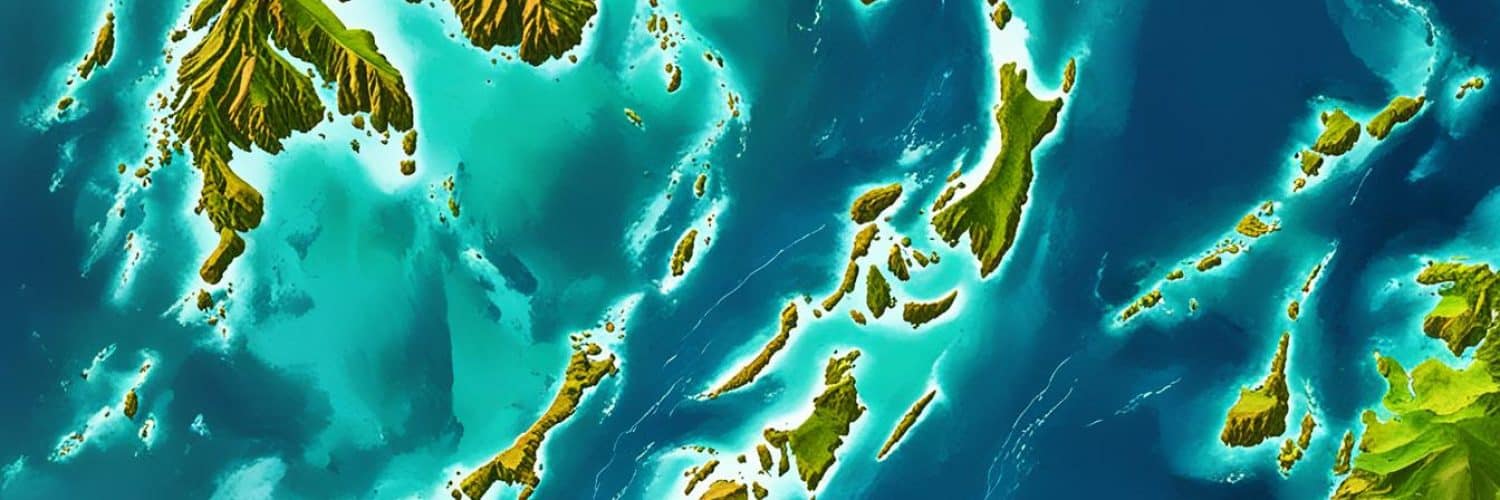


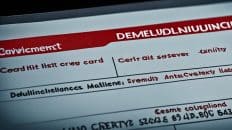










Add comment